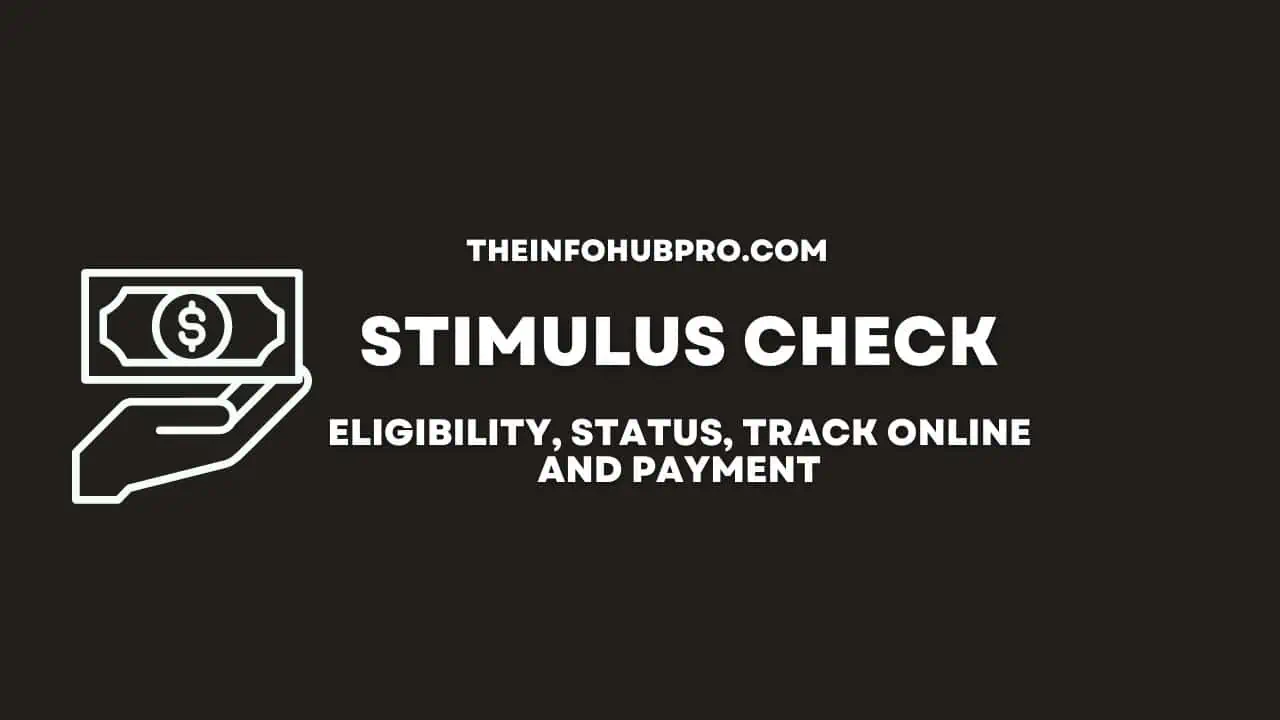Stimulus Check in 2023: Full Details on Eligibility, Status, Payment, and Track Online
If you’re like me, you probably have a lot of questions about stimulus checks in 2023. What are they? Who is eligible? How can you check the status of your payment? And most importantly, when will you get your money?

In this blog post, I’ll answer all these questions and more, using the latest information from reliable sources. By the end of this post, you’ll have a clear understanding of what stimulus checks are, how they work, and what to expect in 2023.
Consider reading: US Population and Area by States
What Is a Stimulus Check and What Does It Mean?
A stimulus check is a direct payment from the federal government to eligible individuals and households. The purpose of a stimulus check is to provide economic relief and stimulate spending during times of crisis, such as the COVID-19 pandemic.
The term “stimulus check” is not official, but rather a popular way of referring to the Economic Impact Payments (EIPs) authorized by Congress under various relief bills.
The first round of EIPs was issued in 2020 under the CARES Act, followed by a second round in 2020 under the Consolidated Appropriations Act, and a third round in 2021 under the American Rescue Plan Act.
Each round of EIPs had different eligibility criteria, payment amounts, and distribution methods. The amount of each EIP depended on factors such as income, filing status, and the number of dependents. The distribution methods included direct deposit, paper checks, prepaid debit cards, and direct express cards.
Stimulus Check Eligibility
The eligibility for stimulus checks in 2023 depends on whether there will be a fourth round of EIPs at the federal level or not. As of now, there is no official announcement or proposal for a fourth round of EIPs from the federal government.
However, some lawmakers and advocacy groups have been pushing for another round of stimulus checks to help Americans cope with the ongoing effects of the pandemic and inflation.
If there is a fourth round of EIPs from the federal government, the eligibility criteria will likely be similar to the third round, which was based on the 2019 or 2020 tax return.
The third round of EIPs provided up to $1,400 per person for individuals with an adjusted gross income (AGI) of up to $75,000, married couples filing jointly with an AGI of up to $150,000, and heads of household with an AGI of up to $112,500.
The payment amount phased out for higher incomes until it reached zero for individuals with an AGI of $80,000 or more, married couples filing jointly with an AGI of $160,000 or more, and heads of households with an AGI of $120,000 or more.
The third round of EIPs also expanded the eligibility for dependents to include not only children under 17, but also adult dependents such as college students, disabled relatives, and elderly parents. Each dependent qualified for an additional $1,400 payment.
However, even if there is no fourth round of EIPs from the federal government, some states have been issuing their own stimulus checks to their residents using their surplus budget funds or federal aid money.
Stimulus Check Eligibility Per State
These state-level stimulus checks have different eligibility criteria and payment amounts than the federal ones. Some examples of states that have issued or plan to issue their own stimulus checks in 2023 are:
- California: The Middle-Class Tax Rebate program provides up to $1,050 per person for individuals with an AGI of up to $75,000 and families with an AGI of up to $150,000 who filed their 2020 tax return by October 15. Most payments have already been distributed by direct deposit or debit card, but some debit cards will be mailed by January 14.
- Colorado: The Colorado Cash Back program provides a tax rebate of $750 for individual filers and $1,500 for joint filers who filed their 2020 tax return by October 17. Most payments have already been distributed by direct deposit or paper check, but some payments will be issued by January 31.
- Idaho: The Idaho Income Tax Rebate program provides 10% of the tax amount on the 2020 income tax return or $300 per person ($600 for joint filers), whichever is greater. The payments are being processed through 2022 and early 2023 as taxpayers file their returns and become eligible for the rebate.
- Illinois: The Illinois Income Tax Rebate program provides $50 per person ($100 for joint filers) for taxpayers with an AGI of less than $200,000 ($400,000 for joint filers) who filed their 2021 tax return by April 18. The payments will be issued by direct deposit or paper check in 2023. The Illinois Property Tax Rebate program provides a credit of up to $300 for homeowners who paid property taxes in 2021 and claimed the Illinois Property Tax Credit on their 2021 tax return. The credit will be applied to the 2022 tax liability or refunded in 2023.
- Maryland: The RELIEF Act of 2021 provides a one-time payment of $300 for individual filers and $500 for joint filers who claimed the Earned Income Tax Credit (EITC) on their 2019 tax return. The payments were issued by direct deposit or paper check in February and March.
- New Mexico: The New Mexico Tax Rebate program provides a one-time payment of $600 for individual filers and $1,200 for joint filers who claimed the Working Families Tax Credit (WFTC) on their 2020 tax return and had an AGI of less than $31,200 ($39,000 for joint filers). The payments were issued by direct deposit or paper check in May and June.
- New York: The New York Excluded Workers Fund provides a one-time payment of up to $15,600 for workers who were ineligible for federal COVID-19 relief due to their immigration status and had an AGI of less than $26,208 in 2020. The payments are being processed by the Department of Labor and will be issued by direct deposit or prepaid debit card by December 31.
- Vermont: The Vermont Frontline Employees Hazard Pay Grant program provides a one-time payment of $1,200 for frontline workers who worked at least 68 hours in certain sectors between March 13 and May 15, 2020. The payments are being processed by the Agency of Human Services and will be issued by direct deposit or paper check by December 31.
Stimulus Check Status Online
If you’re wondering how to check the status of your stimulus check, whether it’s from the federal government or your state, there are different ways to do so online.
For federal stimulus checks, you can use the Get My Payment tool on the IRS website. This tool allows you to track the status of your payment, including the date and method of delivery.
You can also update your bank account information or mailing address if needed. To use this tool, you’ll need to provide some basic information, such as your Social Security number, date of birth, and address.
For state stimulus checks, you’ll need to visit the website of your state’s tax agency, or Department of Revenue. Each state has its own tool or portal where you can check the status of your payment, update your information, or find answers to frequently asked questions.
Stimulus Check Payment
The payment method for stimulus checks depends on how you filed your tax return, whether you provided your bank account information to the IRS or your state, and whether you have a Direct Express card.
For federal stimulus checks, the IRS prefers to send payments by direct deposit, as it is faster, safer, and more convenient than mailing paper checks or prepaid debit cards.
If you filed your tax return electronically and provided your bank account information, you will likely receive your payment by direct deposit. If you did not file a tax return but registered online or used the Non-Filer tool, you will also receive your payment by direct deposit if you entered your bank account information.
If you did not provide your bank account information to the IRS, or if there was an issue with your bank account, you will receive your payment by paper check or prepaid debit card in the mail. The paper check will have “Economic Impact Payment” printed on it, and the prepaid debit card will come in a white envelope with a Treasury seal and a letter from the IRS explaining how to activate and use it.
If you have a direct express card, which is a debit card that delivers federal benefits such as Social Security and Supplemental Security Income (SSI), you will receive your payment on your card if you do not have a bank account on file with the IRS.
For state stimulus checks, the payment method varies by state but generally follows the same logic as the federal ones. If you provided your bank account information to your state’s tax agency or department of revenue, you will likely receive your payment by direct deposit.
If not, you will receive your payment by paper check or prepaid debit card in the mail.
Track Stimulus Check
If you want to track your stimulus check, whether it’s from the federal government or your state, there are different ways to do so online or by phone.
For federal stimulus checks, you can use the Get My Payment tool on the IRS website to track the status of your payment, including the date and method of delivery. You can also update your bank account information or mailing address if needed. To use this tool, you’ll need to provide some basic information, such as your Social Security number, date of birth, and address.
You can also call the IRS Economic Impact Payment line at 800-919-9835 to check the status of your payment or request a payment trace if you did not receive your payment within the expected time frame.
The expected time frame depends on the payment method: direct deposit payments should arrive within five days of the scheduled date; paper checks should arrive within four weeks of the scheduled date; prepaid debit cards should arrive within seven weeks of the scheduled date; and direct express cards should arrive within three weeks of the scheduled date.
For state stimulus checks, you’ll need to visit the website of your state’s tax agency or department of revenue and use their tool or portal to track the status of your payment, update your information, or find answers to frequently asked questions.
You can also call your state’s tax agency or Department of Revenue and speak to a representative who can assist you with tracking your payment or resolving any issues. You can find the phone numbers for these agencies in the references section below.
Closing Thoughts on Stimulus Checks
In this blog post, you learned everything you need to know about stimulus checks in 2023, including what they are, who is eligible, how to check the status of your payment, and what the latest updates are.
You also discovered how to track your stimulus check online or by phone, whether it’s from the federal government or your state.
Stimulus checks are a great way to boost your income and help you cover your expenses during these challenging times. Whether you’re waiting for a fourth round of EIPs from the federal government, or you’re receiving a state-level stimulus check, you can use this blog post as a guide to understand how stimulus checks work and what to expect in 2023.
If you found this blog post helpful and informative, please share it with your friends and family who might benefit from it.
Thank you for reading, and stay tuned for more!





